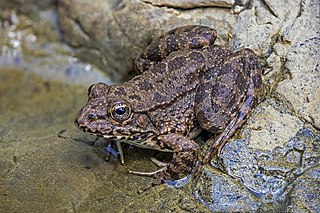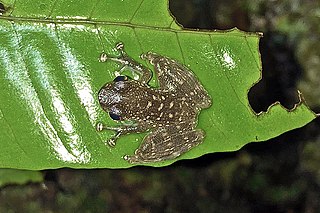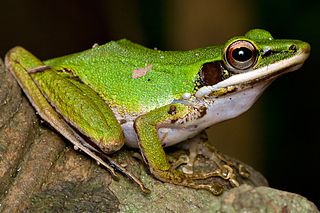
True frogs is the common name for the frog family Ranidae. They have the widest distribution of any frog family. They are abundant throughout most of the world, occurring on all continents except Antarctica. The true frogs are present in North America, northern South America, Europe, Africa, and Asia. The Asian range extends across the East Indies to New Guinea and a single species, the Australian wood frog, has spread into the far north of Australia.

Philautus is a genus of shrub frogs in the family Rhacophoridae from Asia. Some species in this genus are now considered extinct by IUCN, while others are widespread and abundant. The taxonomy of the group is unclear, with many poorly described species.

Rhacophorus is a genus of frogs in the shrub frog family (Rhacophoridae) and the related Hylidae make up the true tree frogs. They are found in India, Japan, China, and Southeast Asia. Over 40 species are currently recognised.

Amolops is a genus of true frogs native mainly to eastern and south-eastern Asia. These frogs are closely related to such genera as Huia, Meristogenys, Odorrana, Pelophylax and Rana, but still form a distinct lineage among the core radiation of true frogs. They are commonly known as "torrent frogs" after their favorite habitat - small rapid-flowing mountain and hill streams - but this name is used for many similar-looking frogs regardless of whether they are loosely related.

Meristogenys is a genus of true frogs from Borneo. Its tadpoles are adapted to fast-flowing mountain streams and easily recognizable by their divided upper lip with ribs on the outside.

Leptopelis is a genus of frogs in the family Arthroleptidae. They are found throughout Sub-Saharan Africa, excluding Madagascar. It is placed in monotypic subfamily Leptopelinae, although this subfamily is not always recognized. They have a number of common names, including forest treefrogs, tree frogs, leaf-frogs, and big-eyed frogs.

Kalophrynus is a genus of microhylid frogs. It is the only genus in the subfamily Kalophryninae. The species in this genus are found in southern China, in Southeast Asia to Java and Philippines, and in Assam, India.

Hose's frog is a true frog species with a wide range in Southeast Asia. This species was named after zoologist Charles Hose.

The hole-in-the-head frog is a species of frog in the family Ranidae. It is the only member of the genus Huia. It is found on the island of Borneo. Its natural habitats are subtropical or tropical moist lowland forests, subtropical or tropical moist montane forests, and torrential rivers. It is threatened by habitat loss. The genus name honors Chinese herpetologist Shuchin Hu.
Meristogenys macrophthalmus is a species of frog in the family Ranidae. It is endemic to Sarawak in northern Borneo (Malaysia) and is only known from its type locality in the Bintulu District. The specific name macrophthalmus is derived from the Greek words macros (="large") and ophthalmos (="eye") and refers to the large eyes of this frog. Common names Matsui's Borneo frog, large-eyed torrent frog, and big-eyed torrent frog have been coined for it.

Nannophrys guentheri is an extinct species of frog in the family Dicroglossidae. It was endemic to Sri Lanka. The species was first identified in 1882 by George Boulenger and named after the German-born British zoologist Albert Günther. It is not known where in Sri Lanka the specimens were found.

The rock skipper, also known as Sabah splash frog, is a frog in the family Ranidae. It is endemic to northern and western Borneo.

Staurois natator is a species of frog in the family Ranidae. It is endemic to the Philippines, where found on the islands of Mindanao, Leyte and Samar. It has sometimes been reported from other Philippine islands and Borneo, but these populations are now regarded as separate species . Its natural habitats are subtropical or tropical moist lowland forests, rivers, and intermittent rivers. It is threatened by habitat loss.

Staurois tuberilinguis is a semi-aquatic amphibian of the true frog family (Ranidae). This diurnal and crepuscular frog is also commonly associated with its very close relative Staurois parvus. In fact, many do not consider the two species to be taxonomically separate. This species is commonly found within the tropical rainforests of on Borneo, Malaysia next to fast-flowing rivers and streams. Due to the frog’s noisy choice of habitat, S. parvus are well-known for their multi-modal system of communication that combines acoustic calls with visual display signals. S. parvus seems to be in decline in part of its range, but overall is listed as being of "least concern" in the IUCN Red List of Threatened Species. It is threatened by habitat loss, especially by deforestation and sedimentation of streams.

Chalcorana is a genus of frogs in the family Ranidae, "true frogs". They are found in Southeast Asia, from Thailand to Malay Peninsula and the Sunda Islands.

Papurana is a genus of frogs in the family Ranidae, "true frogs". They are known from Southeast Asia, New Guinea, and northern Australia. Papurana daemeli is the only ranid frog found in Australia.

Robert Frederick Inger was an American herpetologist. During his lifetime, he wrote numerous books and publications about herpetology. He was also the curator for amphibians and reptiles at the Field Museum in Chicago, Illinois.

Pelobatrachus is a genus of frogs in the family Megophryidae. It was formerly synonymized with Megophrys until 2021, when it was revived as a distinct genus. They inhabit Southeast Asia, namely the Malay Peninsula, Sumatra, Borneo and the Philippines. Their common name is clay horned toads.

















